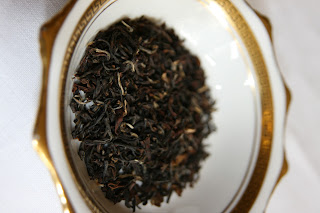http://www.anteaques.co.uk
Brewing; 9 grams for .1 litres, 30 seconds at 60 degrees.
Review; Gyokuros are a beautiful tea, both in taste, appearance, and history. The un-brewed leaves are long, thin and perfectly pinate. However to me the most interesting factor of a Gyokuro is its scientific composition. Gyokuro’s are a Japanese Sencha tea that is shade grown for 3 weeks. This shade growing changes the light spectrum so that the plant has to generate new types of chlorophyll to match this spectrum. Meaning that this tea is a “super enhanced” green tea with artificially increased levels of chlorophyll. What gets even cooler is that plants are only able to produce starch and cellulose molecules in full sun, with a scavenger pathway kicking in resulting in more simple sugars. This entails that one should expect a sweeter taste to this green tea than a regular green tea. Or at least I tell myself so. It is thought that Gyokuro was first made in 1835 in the Uji by Kahei Yamamoto.
Gyokuro is also the base tea that is used for the making of
Matcha in the Japanese Tea Ceremony. In
order to make this fine power, the tea must be stone ground very slowly
(talking about producing only a couple grams an hour) lest the power is heated
too high from the friction and oxidizes.
Gyokuros are made in a specific pot, that you put in at
least 3 times the amount of tea in, with a very small amount of water. Quick infusions still deliver a powerful kick
of flavour that results in multiple different tastes as one progresses from the
first infusion to the sixth. Further
more because of its delicate shade grown nature Gyokuro requires 60 degree
water so as not to burn the leaves.
Taste wise there are beautiful umami flavourings, as well as
spinach, seaweek, sea breeze and a sweetness that leaves the mouth astringent. Snow peas dipped in butter (and maybe a
little salt) in your mouth. No
bitterness or astringency if made correctly.
I’ve also had Gyokuro made other ways including room
temperature brewing and ice brewing. Tea
is such a unique and diverse product, and different flavours, aromas and tastes
all can change depending on how the tea is brewed.
While this tea is particularly expensive, Anteaques again
has provided this high quality tea at an affordable price.
Enjoy
-Tea Fan





